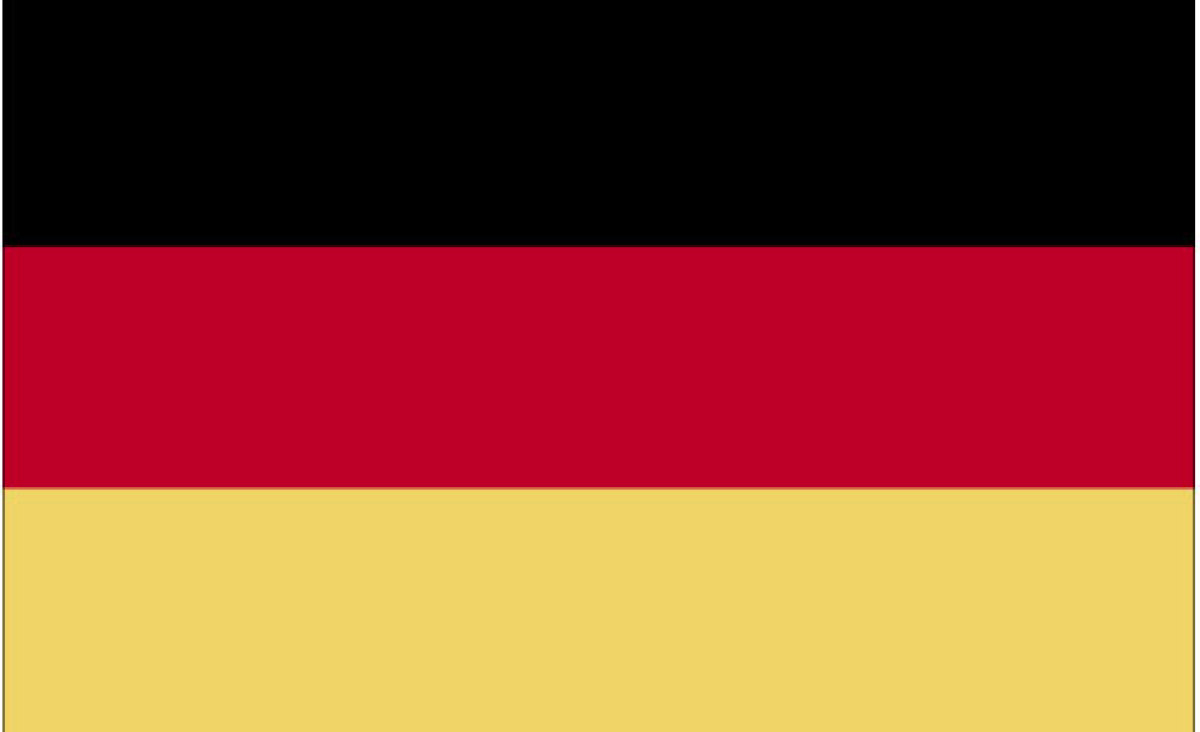Germany Flag

Flag Date of Adoption
9 May 1949
Flag Symbolism
The federal flag consists of three horizontal stripes of equal width, black at the top, red in the middle, and gold at the bottom; the proportion of the hoist (width) to the fly (length) of the bunting shall be 3:5. The federal flag may also be displayed in the form of a banner. The banner shall consist of three vertical stripes of equal width, black at the left, red in the middle, and gold at the right.Flags shall be displayed on the following days:
27 January - Day of Remembrance for the Victims of National Socialism
1 May - Labor Day
5 May - Europe Day
23 May - Anniversary of the promulgation of the Basic Law<
17 June - Anniversary of 17 June 1953
20 July - Anniversary of 20 July 1944
3 October - Day of German Unity
Second Sunday before the first Sunday in Advent
Day of National Mourning
As specifically scheduled:
Day of the elections to the German Bundestag
Day of the elections to the European Parliament
It is generally believed the colors come from the uniforms of the Lützow Free Corps, comprised mostly of university students, that formed during the end of the struggle against the Napoleonic occupation of much of Germany.
Germany National Anthem
| Listen to National Anthem | |
| Anthem History |
The "Deutschlandlied", the German national anthem, dates back to the liberal national movement of the 19th century. The words stem from the pen of August Heinrich Hoffmann The "Deutschlandlied" was initially unable to compete successfully against other songs. After 1871 the Prussian royal anthem "Heil dir im Siegerkranz" ("Hail to Thee in Victor's Laurels"), which had been designated the imperial anthem, was sung wherever Emperor William I appeared. Not until around the turn of the century did Hoffman's song become popular. In 1922, in a speech marking the third anniversary of the Weimar constitution, Reich President Friedrich Ebert publicly proclaimed the "Deutschlandlied", although the term "national anthem" was not yet used on that day. In his speech, Friedrich Ebert stated: "Unity and right and freedom - in times of internal fragmentation and oppression, this triad from the poet's song voiced the longing of all Germans; may it now accompany us on our arduous path to a better future." After the end of World War II, the newly founded Federal Republic of Germany had difficulty reaching a decision on a national anthem. In contrast to the federal flag, no provision was made for an anthem in the Basic Law. Not until 1952 was an arrangement reached. In a letter dated 29 April 1952, Federal Chancellor Dr. Konrad Adenauer asked the Federal President, Prof. Dr. Theodor Heuss, to "designate the song by Hoffmann and Haydn the national anthem. At state functions, the third verse should be sung." President Heuss gave his consent in a response dated 2 May 1952, after his prior attempt to initiate a new anthem, had proved unsuccessful. After the reunification of Germany, in an exchange of letters in August 1991, Federal President Dr. Richard von Weizsäcker and Federal Chancellor Dr. Helmut Kohl designated the third verse of the "Deutschlandlied" the national anthem. |
| Anthem Lyrics |
The "Deutschlandlied"Einigkeit und Recht und Freiheit Für das Deutsche Vaterland. Danach laßt uns alle streben, Brüderlich mit Herz und Hand. Einigkeit und Recht und Freiheit Sind des Glückes Unterpfand. Blüh' im Glanze dieses Glückes, Blühe deutsches Vaterland. |
| Anthem Lyrics English |
Unity and Rights and Freedom For the German Fatherland Let us all strive for that Brotherly with heart and hand Unity and Rights and Freedom Are the foundation for happiness Bloom in the glow of happiness Bloom German Fatherland |
World Regions
All Countries
Afghanistan
Akrotiri
Albania
Algeria
American Samoa
Andorra
Angola
Anguilla
Antarctica
Antigua and Barbuda
Argentina
Armenia
Aruba
Australia
Austria
Azerbaijan
Bahamas
Bahrain
Bangladesh
Barbados
Belarus
Belgium
Belize
Benin
Bermuda
Bhutan
Bolivia
Bosnia and Herzegovina
Botswana
Brazil
British Indian Ocean Territory
British Virgin Islands
Brunei
Bulgaria
Burkina Faso
Burma
Burundi
Cabo Verde
Cambodia
Cameroon
Canada
Cayman Islands
Central African Republic
Chad
Chile
China
Christmas Island
Clipperton Island
Cocos (Keeling) Islands
Colombia
Comoros
Congo, Democratic Republic of the
Congo, Republic of the
Cook Islands
Coral Sea Islands
Costa Rica
Cote d’Ivoire
Croatia
Cuba
Curacao
Cyprus
Czech Republic
Denmark
Dhekelia
Djibouti
Dominica
Dominican Republic
Ecuador
Egypt
El Salvador
Equatorial Guinea
Eritrea
Estonia
Eswatini
Ethiopia
Falkland Islands
Faroe Islands
Fiji
Finland
France
French Guiana
French Polynesia
Gabon
Gambia, The
Gaza Strip
Georgia
Germany
Ghana
Gibraltar
Greece
Greenland
Grenada
Guadeloupe
Guam
Guatemala
Guernsey
Guinea
Guinea-Bissau
Guyana
Haiti
Holy See
Honduras
Hong Kong
Hungary
Iceland
India
Indonesia
Iran
Iraq
Ireland
Isle of Man
Israel
Italy
Jamaica
Jan Mayen
Japan
Jersey
Jordan
Kazakhstan
Kenya
Kiribati
Korea, North
Korea, South
Kosovo
Kuwait
Kyrgyzstan
Laos
Latvia
Lebanon
Lesotho
Liberia
Libya
Liechtenstein
Lithuania
Luxembourg
Macau
Madagascar
Malawi
Malaysia
Maldives
Mali
Malta
Marshall Islands
Martinique
Mauritania
Mauritius
Mayotte
Mexico
Micronesia
Moldova
Monaco
Mongolia
Montenegro
Montserrat
Morocco
Mozambique
Namibia
Nauru
Nepal
Netherlands
New Caledonia
New Zealand
Nicaragua
Niger
Nigeria
Niue
Norfolk Island
North Macedonia
Northern Mariana Islands
Norway
Oman
Pakistan
Palau
Panama
Papua New Guinea
Paraguay
Peru
Philippines
Pitcairn Islands
Poland
Portugal
Puerto Rico
Qatar
Reunion
Romania
Russia
Rwanda
Saint Helena, Ascension, and Tristan da Cunha
Saint Kitts and Nevis
Saint Lucia
Saint Pierre and Miquelon
Saint Vincent and the Grenadines
Samoa
San Marino
Sao Tome and Principe
Saudi Arabia
Senegal
Serbia
Seychelles
Sierra Leone
Singapore
Slovakia
Slovenia
Solomon Islands
Somalia
South Africa
Spain
Sri Lanka
Sudan
Sudan, South
Suriname
Svalbard
Sweden
Switzerland
Syria
Taiwan
Tajikistan
Tanzania
Thailand
Timor-Leste
Togo
Tokelau
Tonga
Trinidad and Tobago
Tunisia
Turkey
Turkmenistan
Turks and Caicos Islands
Tuvalu
Uganda
Ukraine
United Arab Emirates
United Kingdom
United States (US)
Uruguay
Uzbekistan
Vanuatu
Venezuela
Vietnam
Virgin Islands
Wake Island
Wallis and Futuna
West Bank
Western Sahara
World
Yemen
Zambia
Zimbabwe
